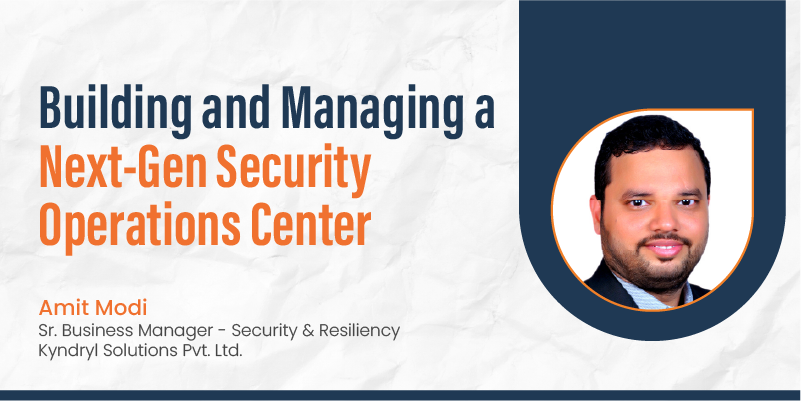Building & Managing a Next-Gen SOC

When it comes to cybersecurity, several organizations are taking it as granted. However, cybersecurity should be the priority for organizations, and it is as important as handling crisis situations such as war, fire, etc. Because of the security hazards involved in the cyber world, there is a need to practice just like the way we handle other crisis situations.
Enterprises have to build and manage SOCs for detecting, diagnosing, and remediating cyberattacks due to the huge volume of malware attacks occurring these days. SOCs support enterprises to enhance threat detection, reduce the probability of data breaches, and ensure appropriate incident management when incidents occur. Cybersecurity leaders understand that a well-built SOC involves the right processes, technology, analytics, and architecture that is accustomed to the threat landscape.
What is a SOC?
Security Operations Center (SOC) is a unified solution within the organization employing people, processes, and technology that helps to monitor and manage the security issues both on a technical and organizational level. The team of professionals who are responsible for monitoring the security systems should scan the systems in real-time. The facility is used to secure the organization’s defense system 24/7 by protecting the security infrastructure from any potential cyber-attacks.
Key Functions of SOC
The key functions of SOC are:
- Real-time Monitoring
- Risk Management
- Vulnerability Scanning
- Security Incident Detection & Mitigation
- Intelligent Analysis & Correlation
- Security Incident Analysis
One of the key functions of the Security Operation Center (SOC) is real-time monitoring of the security, which is very important to detect and identify the threats that reach the organizational network. Once the threats are identified, there are multiple ways to mitigate them. The threat incidents are mitigated through risk management, vulnerability scanning, investigating the incident, combining all the elements in a single correlation engine, and then analyzing the incident. These key functionalities of the SOC help the security professionals to get an actual output.
What are the Responsibilities of SOC?
Security Operations Center is the first line of security in an organization against immediate and impending cyberattacks. It uses strategic security processes and methodologies to keep active surveillance as well as real-time security analysis of the organization’s security infrastructure. The SOC team carries out the following tasks:
Identifying the Assets: SOC operations begin with identifying and understanding of tools and technologies, and the team must be familiarized with them. They also learn about hardware and software running on the systems. The in-depth understanding of tools and technologies helps them to detect the potential cyber threats and existing vulnerabilities at an early stage.
Proactive Monitoring: The SOC mainly focuses on the detection of malicious activities within the network that may lead to vulnerabilities.
Manage Logs, Configuration Change, and Response: Systematic management of activity logs enables a cyber forensic investigator to locate the vulnerable points.
Rank Alerts: When a threat or irregularity is detected by the SOC team, it is ranked based on its severity. Prioritizing the severity of the threat is helpful in creating a proper response to the incident.
Adjust Defenses: The defense mechanisms are adjusted by the SOC based on the vulnerability management strategies and increase its threat awareness, which enables the team to be alert for security breaches.
Compliance: The SOC team also verifies whether the organization complies with the regulations and standards.
Notify Security Breach: When the organization experiences security incidents, it is expected to have minimal or no network downtime. The SOC team warns the stakeholders immediately to ensure business continuity.
Success Pillars of SOC
How to make a SOC strategy successful? What are the things to be looked at to make it successful?
Three major things must be considered to have an ideal SOC strategy: Innovation, Scalability, and Automation. In a crisis, it is very important to innovate and evolve. Innovation is the key to developing new solutions because no readymade solutions are available when there is a crisis. When a situation arises and to defend an organization during the crisis, the defensive mechanisms should be scalable as scalability enables the organization to expand and restrict based on the demand that arises. Once the innovation and scalability are achieved, then those must be compiled into the automated system. In the future, if the system experiences the same kind of incident, then the automated system will take care of that incident.
How do you achieve scalability and automation with respect to SOC or security operation center?
There are three major elements involved in it such as people, process, and technology. Today, organizations are investing in technology and 15-20 cybersecurity or technology solutions have been implemented by organizations. It is necessary to establish the key processes required to build a SOC, which includes prioritization, analysis, categorization, remediation, improvement, and assessment. Once there is technology and process, the enterprise has to hire people who can use and implement the technology and process.
SOC Building Journey
The first and foremost thing required to build a SOC is to assess a particular environment to understand what objective must be achieved, whether to monitor the security incidents or onboard the business, cloud, and applications. Once the organization has understood the objective to build the Security Operations Center, the team members and devices have to be onboarded to build a SOC team.
The SOC team is a group of cybersecurity professionals who protect the organization by monitoring, identifying, analyzing, and investigating cyber incidents. The team evaluates the feeds, establishes rules and regulations, and identifies and categorizes logs based on the severity level- Critical, Major, Minor, and Informational. The team integrates procedures to all devices and creates security awareness amongst the departments.
The SOC team defines the correlation rules, logic, and workflow based on which customized dashboard will be created as per the requirement. All this information will be compiled together into an automated system. SOC Operation Manual (SOPs/Run Books) will be created, which consists of standard operating procedures with defined goals, objectives, mission, and charter.
Then, BCP documentation will be prepared for SOC devices, which outlines a disaster recovery plan that consists of how the organization has to continue with the business during a crisis situation. A backup procedure also has to be done to ensure the safety of the data so that in case of a disruption, the data will be available for various processes. Incident management policies and procedures, and reports are scheduled and created. The final step in a SOC building journey is training the team to envisage the crisis situations and enable them to think and act before hackers.
SIEM Evaluation Criteria
SIEM or Security Information and Event Management tools are used to collect, store, analyze, and report data for a complete evaluation of the cyber incidents faced by the organization. Here is the SIEM checklist that helps to address the incidents with the right response.
- Real-time monitoring and alerting
- User activity monitoring
- Use case investigation
- Threat detection/intelligence
- Forensic capability
- Data analysis
- Automated response capabilities
- Long-term event storage
- Scalability
- Cloud-ready
- Integrate with business applications and infra devices
- Reporting
Evolution of SOC
There are five stages in the evolution of SOC. The five stages are:
Level 1: Unaware
Organizations are unaware or unable to respond to security issues because of the lack of necessary information.
Level 2: Reactive/SOC
Majority of organizations have basic security operating center solutions and structures to react to IT security issues. The reactive phase is a phase in which organizations react only after the incident.
Level 3: Proactive
Few of the organizations possess platforms and structures to proactively address IT issues and security challenges. The proactive phase is a phase in which the organization predicts the threats beforehand and takes actions against such impending threats.
Level 4: Anticipatory
In this phase, the organization creates a process and adds a structure for the process, and understands the IT-related challenges. Whenever there is an incident, the organization will make use of this information to deal with the challenges
Level 5: Automation
During this phase, the organizations have their automated and intelligent platforms, , deep learning technology, and orchestrational structures for predicting IT security issues with subsecond reaction time for future security challenges.
SOC as a Business Enabler
The security operation center needs to be a business enabler as it has to make sure that the business applications, databases, and data are secured. Organizations are not ready to compromise on security.
SOC can be a business enabler by:
- Picking up the logs from business applications, databases, etc.
- Building the use case based on the problem statement of the business owners.
- Defining the expected output
- Picking up the data sources and fields from those applications and databases
- Creating the logic based on the expected output against the problem statement
- Defining the action, priority, and output to test it further
- Refining the same on a regular basis
Visualizing the Next-Gen SOC- Technologies and Process
While visualizing the next-gen SOC, it is essential to ensure that the onboarding of endpoints, tools, IT infrastructure, applications, and databases are part of the system. All these have to be done in compliance with GRC to make it process-oriented.
Conclusion
Considering the evolving challenges in the cyber world, security operation centers also have to evolve based on the requirements. By building and managing a next-gen SOC, an enterprise can save reaction time during crisis situations. Since SOC will be ready to meet the challenges by creating solutions against the threats, enterprises can operate their businesses with next-level control. Know more in detail.



